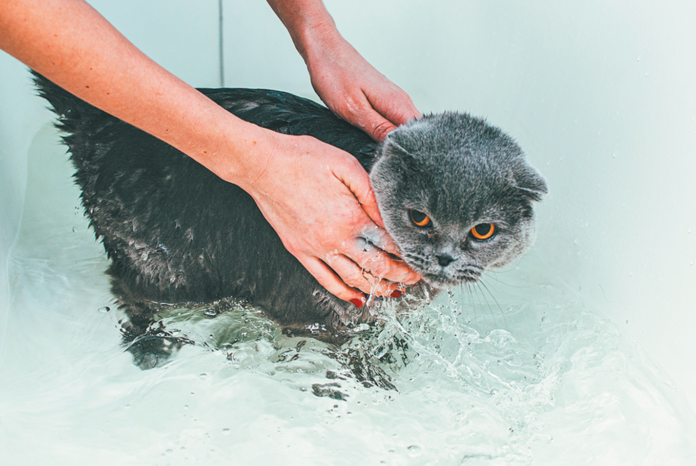Although most cats spend a lot of time cleaning themselves with their tongues and teeth (which they use as combs to rake their fur), many could still use a bath once in a while. They become dirtier than their own grooming tools can handle, getting a gummy feel that sets up their skin for feeling irritated or even for infections. But how do you do it without turning bathing into a knock-down, drag-out fight? Here are 10 tips.
- Choose a time that your cat is feeling mellow. The ASPCA suggests tiring out your pet by playing with him first. That will not only give him less energy to fight you; it’ll make him feel more bonded to you and perhaps more apt to be cooperative.
- Make sure your cat’s claws are trimmed. If you get scratched, it won’t hurt as much, and that will keep you calmer — which will keep your cat calmer.
- Whether in the sink or the bathtub, put down a rubber mat so your cat does not find himself slipping and sliding during the cleansing. That will reduce his struggle with you; many cats panic when they feel unsteady on their feet.
- Go with your cat’s preference for how he will be wet down. Veterinarian Marty Becker, DVM, who developed widely-accepted criteria for “Fear Free” pet care, says some cats feel water coming from faucets or nozzles as sensation overload and would rather have water poured on them from a cup.
- Speaking of water, keep it lukewarm — not hotter and not colder. Your cat definitely does not want to experience a temperature extreme.
- Not the face. A cat really does not want his face soaking. Bathe him just from the neck down, working from head to tail in the direction of hair growth. (The ASPCA recommends making the shampoo dilute — one part shampoo to five parts water.) If you do need to clean your feline friend’s face with moisture, use a wipe. Don’t lengthen the bath with that activity. You can clean his face another time, offering him treats and cooing for cooperating.
- Try the spa treatment. Putting lavender or chamomile scents in the bathing area might help keep your cat calm, Dr. Becker says.
- Speak sweetly and gently to your cat throughout, and think of massaging the soapy water into him as a soothing gesture.
- Use drying time as coddling time. If your cat enjoys being picked up by you, hold him — loosely — inside a towel or two and gently press and rub to dry him. You’ll get wet, but so what? You can tidy up afterwards.
- Always end on a good note, even if the bath didn’t go well. Proffer a delectable treat and let your pet know in general that you think he’s great. That will serve to make him more amenable to a bath the next time.
If your cat is particularly anxious, and especially about water, start not by bathing him with soap and water but by cleaning him once in a while with pre-moistened wipes. There are wipes like baby wipes but made just for cats. They contain conditioners and antibacterials formulated for feline hair.
Then, here and there, play with your pet and give him treats near the bathing area — whether that’s in the bathroom or over by the kitchen sink. You can even turn on the water and fill a cup with water but not put him anywhere near it. Just the sounds and the actions may help desensitize him — and may even interest him. After a few of those sessions, he might be more amenable to being bathed.
If he’s not, it’s not the end of the world. You can still use wipes on him. There are even dry shampoos in powder form that you shake onto your cat’s body from a container and work into your cat’s coat and skin with your fingers (wear rubber gloves) before brushing through.
Foams are another option. They do slightly dampen the fur as they are worked in, but some people whose cats abhor the idea of baths prefer them to powders. Foam makes it easier to towel off any residue and is a less messy procedure overall. The foam stays on the cat rather than sprinkling all around.





I have found a decent solution to bathing my cat: I have a shower with doors, not a shower curtain; and a hose on the shower head. I dress in jeans and a sweatshirt to guard against claws and teeth, and warm the water and leave it on low volume before I ever bring the cat in. Then we both get in the shower, water already running so no surprise there, and close the door. He is free to wander around a little, doesn’t have to be held, and we both get wet. Using the hose guarantees fresh water for washing and rinsing.